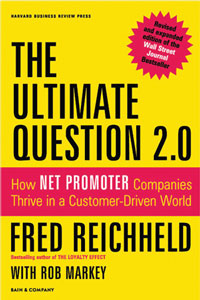
Thousands of companies and brands, large and small, have been able to tap into what’s become known as The Ultimate Question: Would you recommend this business to a friend?
The resulting Net Promoter Score (NPS) is a system and a concept that can be adapted in full, or philosophically in part, by businesses of all sizes.
Authors Fred Reichheld and Bob Markey have counseled clients the world over to communicate the principles of their work which measures how owners and executives are revolutionizing the experience of their customers through business practices that put the customer first.
Thousands of companies are using the Net Promoter score to measure and improve the customer experience. “The ranks of zealous customer advocates continues to grow,” said Fred Reichheld, Bain Fellow and often-acclaimed “godfather of customer loyalty.”
“What started out as only an idea has become a quiet revolution. Net Promoter companies are now mobilizing entire organizations around the single mission of delighting customers,” he said.
According to the authors, effective Net Promoter Systems require three components to be in place:
1. A simple and reliable metric for gauging how well you have earned your customers’ loyalty.
2. Operational processes to support closed-loop feedback, action and learning by front-line employees.
3. Making the mission of earning customer and employee loyalty your company’s #1 priority.
“In just eight years, NPS has evolved from a powerfully simple metric for measuring customer loyalty to a full-blown business system for earning the loyalty of your customers and employees,” said Rob Markey, co-author and global head of Bain & Company’s Customer Strategy and Marketing Practice. “This is no longer about simply taking your customer’s pulse, it’s about creating a culture through a systematic approach to fostering enthusiastic loyalty.”
The Net Promoter Score (NPS is a registered trademark) of a company is a common measure of customer loyalty and is calculated by taking the percentage of customers who are promoters (P) and subtracting the percentage who are detractors (D), based on their response to the “Ultimate Question:” How likely is it that you would recommend this company to a friend or a colleague? Responses are measured on a scale of 0 to 10; 9 and 10 are promoters, 7 and 8 are passives and 0 to 6 are detractors.
Companies that use the score find a tight link between profitable growth and NPS. In most industries, including financial services, retail, technology and telecommunications, the NPS leader has grown at more than twice the rate of the competition.
A full range of resources about the NPS system and approach, including podcasts, case studies, reports on how specific (and varied) types of business are using the surveys as well as helpful quizzes and a free e-newsletter are available on Bain & Company’s website at www.netpromotersystem.com.
Learn more about 2016: The Year of CX/Customer Experience at VisionMonday.com.